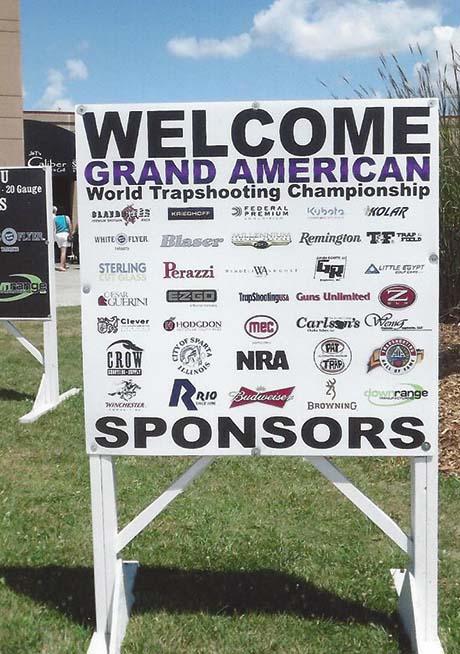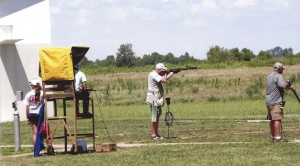by Larry S. Sterett | Contributing Editor
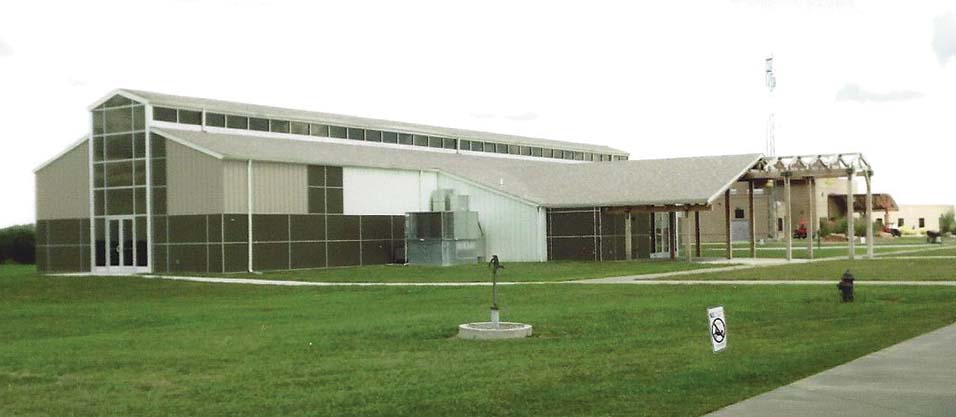 The big news at the August 2015 Grand American was Illinois Gov. Bruce Rauner’s announcement that the World Shooting & Recreational Complex north of Sparta, would be closed on Sept. 1, 2015, due to lack of funds. According to at least one report, the Complex costs approximately $3 million to operate per year, but takes in only $1 million per year. If this is correct, the taxpayers are subsidizing the Complex. Meanwhile, the new Amateur Trap Association’s Hall of Fame opened.
The big news at the August 2015 Grand American was Illinois Gov. Bruce Rauner’s announcement that the World Shooting & Recreational Complex north of Sparta, would be closed on Sept. 1, 2015, due to lack of funds. According to at least one report, the Complex costs approximately $3 million to operate per year, but takes in only $1 million per year. If this is correct, the taxpayers are subsidizing the Complex. Meanwhile, the new Amateur Trap Association’s Hall of Fame opened.
Considering the size of the complex, the mowing, road repair, building maintenance, etc. would amount to a tidy sum. If the events being held at the site were all as large as the Grand American, it shouldn’t be a problem for it to stay in the black. The problem is, the Grand American is the largest event held at the WSRC each year, and it doesn’t produce enough revenue to operate the entire complex.
Operated by the Illinois Department of Natural Resources, which does maintain a small office on the grounds in addition to having a trailer present during the Grand, the complex is similar to a state park, but without entrance fees. (This shooter may be incorrect, but he seems to recall that entrance to the grounds at Vandalia, OH, required a pass or a fee, at least during the day.) When an inquiry was made at the DNR office relative to the possible closing this shooter was informed the date, Sept. 30, depending on how the Illinois state budget problem was settled…or not.
Editor’s note. “Not” is the operative word. In late October the state’s extensive and long-running budget problems were still unresolved. Pension payments, and most vendor payments, were delayed. Happy state lottery winners were disappointed when they received state IOUs instead of cash. Bond payments were being made but the investment rating for the City of Chicago was downgraded to “junk” status.
There is no doubt having the Grand American at Sparta helps the area considerably. According to the Sparta Chamber of Commerce, the area looks forward to the Grand each year. “It means a lot of revenue, including tax revenue, to this area.”
When asked about hotel rooms in the area, for those shooters not camping at the complex, Michael Hays of the Sparta CC stated, “It is hard to find a room in the immediate area.” (This has to be the understatement of the year.) Some shooters stay as far away as Staunton, Belleville, Pickneyville, Chester, O’Fallon, Perryville, Missouri, and possibly even further. The local hotel/motels have a tendency to increase rates during the Grand, when a $60 room suddenly becomes a $139, plus room tax.
The annual Trapshooting Hall of Fame Induction Banquet was held Aug. 11 in the Main Events Building at the WRSC. This year’s inductees included two men from Nebraska, Jim Bradford Jr. (Norfolk), and Richard Marshall Jr. (Lincoln), and a lady from Coldwater, MI, Jacque Snellenberger.
Jim Bradford Jr., just out of the Army and attending Creighton University, attended a trap shoot at a nearby club in October 1969. A true neophyte, he was even equipped properly, but with some pointers and proper shells and equipment he shot a number of rounds and won a small turkey and ham. He was hooked. The following year he joined the ATA. His first 100 came at the Norfolk Gun Club in 1974 and his first 200 at the Sioux Falls, SD, Crooks Gun Club in 1979.
Bradford has been ATA President, and currently is Chairman of the ATA Hall of Fame Board of Trustees. He was a leader on the ATA Relocation Committee from 2001 until the decision to relocate to Sparta. He also advocated moving the Hall of Fame to Sparta, and led fundraising efforts to build the modern facility now on the WSRC grounds. He still runs a thriving insurance business.
Richard Marshall Jr. has earned four Grand American rings. The first was for the 2000 Doubles Championship during which rain and lightning caused a hold-over until the next day. (Less than two hours after the shoot-off concluded Rick received another reward, a phone call that son Tre had been born.)
At the 2005 Grand, the last one held at Vandalia, Marshall accomplished a tremendous feat. He ran the first 700 targets of Grand Week, and completed his Grand American Grand Slam. (His first Grand title, the sub-junior Doubles Champion, was achieved in 1988, and he is currently the only shooter to ever win the Cornhusker Cup at the Nebraska youth tournament three years running.)
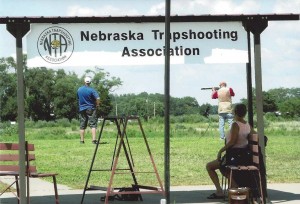
Nebraska was letting shooters know of their presence at the Grand. The group of shooters from Brazil wearing their distinctive shirts was present again this year, but they did not have a sign or specific meeting area.
Nebraska was letting shooters know of their presence at the Grand. The group of shooters from Brazil wearing their distinctive shirts was present again this year, but they did not have a sign or specific meeting area.
Nebraska was letting shooters know of their presence at the Grand. The group of shooters from Brazil wearing their distinctive shirts was present again this year, but they did not have a sign or specific meeting area.
Nebraska was letting shooters know of their presence at the Grand. The group of shooters from Brazil wearing their distinctive shirts was present again this year, but they did not have a sign or specific meeting area.
Through the 2015 target year Marshall has earned 50 titles from eight of the ATA’s Satellite Grands, has been a member of the men’s All-American team every year since 1997, and has posted 25 perfect C’s from the 27-yard line, the first in June 1998. (He also has more than 160 Doubles 100 straights to his credit.)
Jacque Snellenberger attended her first Grand American when she was six days old…as a spectator. (She was not permitted to shoot until she was 15, and began registering targets in 1985.) With her 2015 Hall of Fame induction she, and her father, George, become the second father-daughter duo so enshrined, following Kay Ohye and Deborah Ohye-Neilson.
She moved to the 27-yard line in 1993 at the Battle Creek Gun Club. In 1994 she broke her first 100 straight, with her first 200 later the same year at the Maryland State Shoot. Twice she has won Michigan women’s singles titles with 200 straight. (In 2006 Snellenberger, who is a fifth-grade teacher, was inducted into the Michigan Trapshooting Hall of Fame.)
In 2001, Jacque captured the Vandalia Handicap title to become the 10th female to win any handicap race at the Grand. (Close doesn’t count, but a young female was one target shy of winning the Grand American Handicap in a night shoot-off a couple of years or so prior to the Grand leaving Vandalia.) She has 27 ladies’ crowns at various state and Satellite Grand shoots, in addition to numerous other trophies, and nearly 80 Grand trophies, all since 1995.
Breaking targets consistently takes concentration, as evidenced by these handicap shooters.
The Trapshooting Hall of Fame on the grounds of the WRSC is finished…almost. According to Bradford, “It looks nice. The only thing that is not finished is cabinetry that is being built for exhibits. It will be delivered at the end of August.” (The moving process for the artifacts will begin around September 20, when the three-year storage commitment at the old Hall of Fame in Ohio runs out.)
The building, which was designed by the same architect who planned the entire WRSC, was dedicated on Aug. 9, and those attending were allowed to tour the empty building. According to Bradford, the project originally estimated to cost $2.1 million, will cost about $2,162,000. Funding is still about $380,000 short, and some pledges have been made to be paid in installments. (Bill and Leeann Martin of Utah, pledged $1 million last year after being inducted into the Hall of Fame, and have already paid off their pledge.)
According to Bradford, once the new building is ready for visitors it will have lot of guns and artifacts on display, including early photographs, reloading equipment, and trophies. (Just prior to the old Hall in Ohio closing, the committee was able to acquire thousands of old photographs from a studio in Dayton. These will be sorted and put on display, possibly on a rotating basis.) Assuming the complex is in operation next year, a visit to the new Hall of Fame should be well worth a visit.
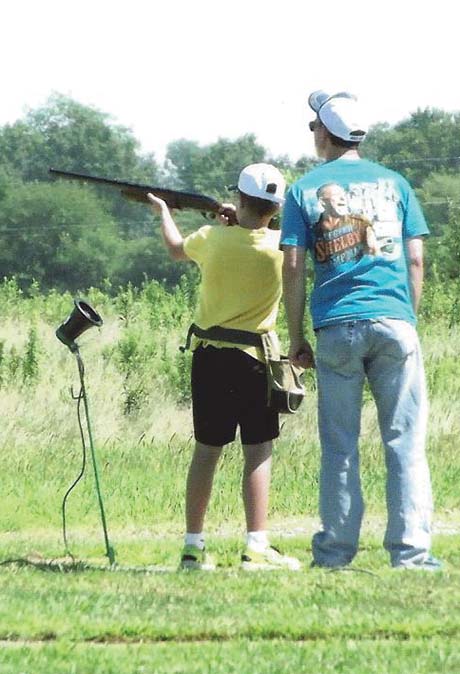
Young shooters get a bit of practice time, and coaching, along the west end of the trap line, as shown here. Yes, he did break the target; not powdered, but broken.
A problem which may have been present, but which was not overly noted, was with the purchase of ammunition during shooting events. People who do not reside in Illinois or its five contiguous states—Indiana, Iowa, Kentucky, Missouri, or Wisconsin—are required to purchase an Illinois hunting license in order to purchase guns or ammunition outside the complex grounds. This has been streamlined to a 24-hour waiting period for facilities off the complex grounds. This waiver does not apply to retail outlets, such as Walmart, which posted an explanatory flyer in the store.
“Due to the state of Illinois’ policy changes, in order for Walmart to be able to sell you ammo, you will need an Illinois FOID card or have a driver’s license from Iowa, Missouri, Kentucky, Indiana or Wisconsin. Residents 18 years of age or older from states not mentioned above will need to have a current Illinois non-resident license or a valid FFL (Federal Firearms License) number.”
Illinois state Rep. Jerry Costello II, at an earlier meeting in Sparta to explain the law to local residents, stated he would like to have gotten fewer restrictions, but the tide of Chicago politicians pushing for stricter laws was too great. (The number of state representatives an area has is based on its population, and half of Illinois’ population resides in just two counties—Cook and Dupage. The balance of the population resides in the other hundred counties) Costello also stated Chicago politicians don’t care as much about tax revenue, but about people trafficking guns to Chicago gangs. “But the shoot-outs in the city of Chicago aren’t between people with permits,” added NRA lobbyist Todd Vandermyde, who was present with Costello.
Every shooter at the Grand has a story, but some are more interesting than others. Jack Noftz, a 15-year-old from Pittsburgh, PA, was attempting to make it onto the ATA Sub-Jr. All-American team. (He will move to the Jr. Division next year.) He arrived in Sparta on July 31, and began competing on Aug. 1 in the AIM (Academics, Integrity, Marksmanship) shoot. Shooting consecutively for so many days can be tough, especially mentally.
“You can tell if you’re out there shooting if you’re in that zone.” Noftz stated. “When I shot those two 100s straight, I could just tell. I was there. And, when I missed a target the next day I could tell. I was thinking about something off topic. That’s all trapshshooting is…just keeping our head in the game all the time. “
Noftz has been shooting for five years, and has competed at the Grand American for three years. He has already reached the 26-yard line in handicap, which is a great achievement for a shooter his age. “I didn’t have my first 100 straight until last year. I didn’t have another one until June of this year. I’ve ended up having six since. (He shot two straight 100s in the singles. and finished second in both events in the ATAs carry-over system.) I’ve had my good days and I’ve had my bad days. You just have to keep on fighting for the rest of the shoot.”
With the dedication he has, Jack Noftz may win the Grand American Handicap some year. The 2014 GAH winner was another Pennsylvanian, Adam Stefkovich of Avella. It was his first trip to the Grand.
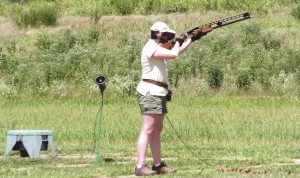
Many shooters at the 2015 Grand were noted to be shooting Unsingles with an extra high ventilated rib, as is this lady shooter.
Although the 2014 Grand American Handicap winner was a first-timer at the event, the 2015 GAH Champion has been attending for about 30 years. Mike Welte of Evansville, IN, has been shooting trap for 32 years, but not a single event during that time could have topped his time at Sparta in 2015. Shooting a 99 in the Handicap is not unusual, but this year there were only two such shooters, Welte and Bill Grill from Michigan; no shooter broke 100 this year. Hence, a shoot-off was necessary, but only after a wait of a couple of hours.
“I really didn’t know how many people would be involved in the shoot-off, or whether there would be a 100 or not,” Welte said later. “There wasn’t a 100. On a really good day someone usually lucks out and breaks them all and usually there are two or three 99s and five or six 98s.”
“It was pretty nerve-racking,” Welte said following the shoot-off. (Welte shoots from the 26-yard line, while Grill shoots from 27 yards.) “He [Grill] missed the first two. That should have calmed me down, but it didn’t. I think I got nervous myself, and then I missed one.”
Immediately afterwards, with reality setting in, Welte couldn’t remember how many targets he had broken only moments previously. “Twenty-two I believe. I’m not sure,” Welte stated. (He broke 23 targets, and Grill broke 22.) “I was just trying to do one at a time. I’m a little overwhelmed right now. I think anyone would be, a major deal like this. Everyone dreams about it, but yes, it’s a blur.”
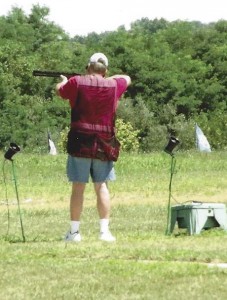
Each trapshooter has his or her own particular stance. This gentleman, with his over/under, is classic.
The high point of his long career? “Oh definitely, without a doubt. Indescribable,” Welte said. (The fans in the bleachers behind Welte didn’t bother him. “I had my earplugs in so deep I couldn’t hear anybody say anything.”)
Although the Grand American Handicap was won by a long time trapshooter with more than three decades of experience, there were many new shooters, and young shooters participating at the WRSC in 2015. In addition to Jack Noftz there were other teen-agers blasting the clays. Sparta, IL, 16-year-old Blaise Lake took the Class D top honors in the Clay Target Championship by breaking 195 out of 200 targets, as did two other shooters. In the shoot-off Lake was straight on all 25 targets; the other two shooters missed one target each. Lake has been shooting in competition for two years, and this was his first Grand American trophy. (Lake obtained a third place award in the Sparta-held US Open in June 2015.)
Although the complete numbers aren’t in yet, there were approximately 4,500 shooters competing for Grand American honors at the WSRC. Many shoot more than one event during the ten days, and at a minimum of 100 shells per event, not counting shoot-offs, that amounts to nearly half-a-million empty hulls. Some shooters save their empties for reloading, some trash them, but most are simply ejected onto the ground to be collected later by WSRC employees.
Now those empties, or most of them, will be collected and used as a source of funds for the Sparta school district, according to district superintendent, Larry Beattie. Roughly two semi-trailer loads of the empty hulls will be hauled to the high school to be sorted, as time permits, by student volunteers. Counting the events shot, shoot-offs, plus practice shooting, and trying out a new model shotgun, the number of empty hulls could number two million or more. (The empty hulls are sold to reloading companies and possibly to sporting goods stores for resale to handloaders.) Any student group or club would get a cut of the funds, split with the ATA, for use in helping with athletic, band, or club activities, if the students are interested. At a penny each, or possibly more, a school or club could be splitting twenty grand, which is not exactly chicken feed to a school district’s activities fund.
The weather at the 2015 Grand American was better than in some past years, warm, but not extremely hot, and no violent thunderstorms. There were some winner surprises, which are great, but the 2015 Grand American is now in the books, as they say. God willing, and the creek don’t rise, the 2016 Grand is slated for Aug. 3-13, with the 2016 Grand National Youth Trapshooting Championships slated to be held just prior at the WSRC.

